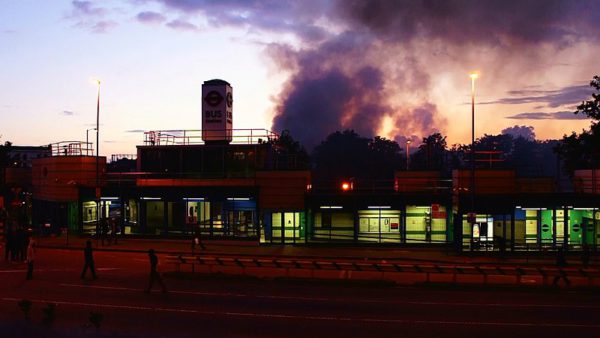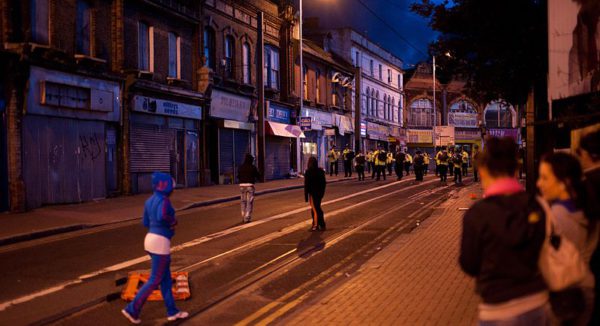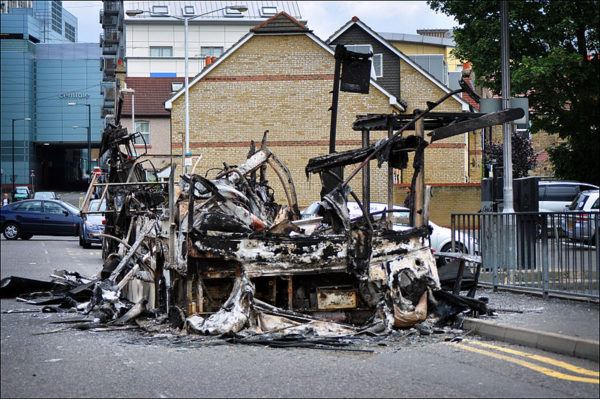Understanding the spread of rioting across a city as control by the crowd
John Drury,1 Clifford Stott,2 Roger Ball,1, 2 Fergus Neville,3 Steve Reicher,3 Sanj Choudhury1
1.University of Sussex, 2. Keele University, 3. University of St Andrews

In this blogpost, I describe some of the initial findings from our ESRC-funded project ‘Beyond contagion: Social identity processes in involuntary social influence’. Part of the work involves analysis of the riots which took place in a number of cities and towns in England in August 2011, which we are using to understand how urban riots (and indeed many other behaviours) spread across people and locations. The 2011 riots began in London, and the initial spread took place across that city. In a complementary analysis to ours, Matteo Tiratelli (2018) argues that to understand patterns of spread and choice of targets in the London riots, we need to examine participants’ relationships with public spaces; in his analysis, the pattern of spread reflected participants taking control of areas within which they normally felt disempowered. In this analysis, the term ‘crowd control’ is turned around to mean not control of a crowd, but control by a crowd.
Our own analysis confirms and extends Tiratelli’s argument. First we have looked at the question of what kinds of behaviour predominated in each riot location. At the time, a number of commentators pointed to the apparent prevalence of looting of high-end good and trainers as evidence that these were ‘consumerist’ riots motivated only by narrow, personal gain. Our fine-grained analysis, drawing upon a much larger data-set than any previous research and reconstructing in detail the sequence of events at the first seven London locations of the riots, suggests a more nuanced story and flatly contradicts the suggestion that these were all principally commodity riots. The initial rioting in Tottenham was essentially an anti-police or community riot, and like all urban riots of this type it had the coherent aim of defeating the police, driving them out of an area, and taking control of that area.

Second, in our first journal publication from the project, we addressed the question of how rioting initially spread in North London. Within this there are two sub-questions: that of the change in norms and targets over time; and that of the spread to other neighbourhoods. On the first point: we found evidence of dynamic change in group norms in the crowd as the rioting extended from Tottenham High Road to Tottenham Hale and Wood Green. A shared anti‐police identity among participants superseded local postcode rivalries, forming the basis of empowered action not only against the police but to address more long‐standing grievances and desires (including looting). Collective psychological empowerment appeared to operate in a ‘positive feedback loop’, whereby one form of collective identity-enactment (and perceived inability of police to respond) formed the basis of further action.
In our second journal paper from the project, we show how the spread to other neighbourhoods – in particular Enfield, the day after the Tottenham events – is partly explicable in terms of the sustained empowerment of Tottenham participants, who travelled to Enfield town centre. However, another factor was actions by police (such as shutting down the town centre) which inadvertently drew other rioters to this location. A further key finding here was that acts which might initially have appeared to be motivated by the desire for commodities or indiscriminate destruction – such as smashing certain shop windows – appeared instead to be strategic acts intended to draw the police into conflict.
A third question, how the riots spread from North to South London, is being addressed in our current work. In North London, it was clear that people often travelled from the initial locations to nearby targets. Yet this doesn’t seem to be case for the riots in Brixton, Clapham and Croydon, the occurrence which instead provides prima facie evidence for sociological models of riot spread according to which riots influence the likelihood of other riots (over and above deprivation, police behaviour and the other major predictors). Our task here is to understand process. Our preliminary analysis is consistent with a multi-stage process in which people in South London who identified as anti-police felt empowered by the events in North London. They understood the North London rioters as a wider ‘us’ or ‘we’ against the police, and they were able to imagine the possibility of similar events happening in South London. They then circulated the call for mobilization and the expectation of riots to their wider networks; thus, we suggest, the influence of the North London riots on each individual was mediated through the support expressed by those circulating the calls. For those within the network, it appeared that ‘everyone’ (in their ingroup) anticipated (and was supportive of the idea) that a riot was going to occur in Brixton. A third stage occurred when the rioting was already happening in South London; this would have increased levels of collective efficacy among others who identify as anti-police who then joined in.

The dominant understanding of the spread of the riots across London – ‘contagion’ or ‘copycat’ – pathologises social influence and suggests that these events were mindless. Our detailed analysis of the development of rioting across seven London locations problematizes the notion of contagion: only those with an anti-police identity joined in and their actions varied rather than simply mimicking each other. Our analysis suggests instead that the process of spread is identity-based (hence limits to participation and targets) and is a function of collective empowerment. Defeating the police and acting against property with impunity empowered many participants to further enact their desires and grievances, both spatially and temporally. Damage to many properties was not (as many commentators tried to suggest) a form of community ‘self-destruction’; these locations were not seen as part of self but rather were understood as expressing the power of an alien other. Control over space in the city was therefore a fundamental feature of the spread of the 2011 London riots.
Further coverage of the project is also available in a recent BBC Radio 4 interview with Stephen Reicher and an article by John Drury in The Conversation.